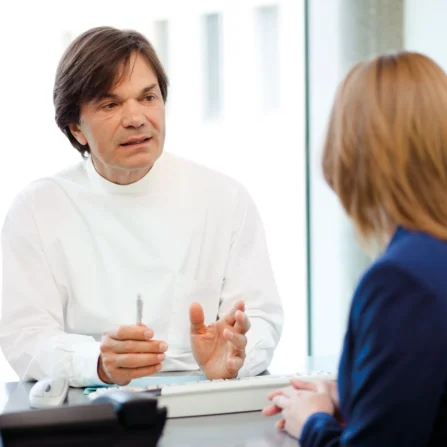Interview with Dr Luigi L. Polla by RTS journalist Laurence Gemperle
Dr Luigi L. Polla - Dermatologist and founder of Forever Institut
Doctor Polla, you opened your institute in 1997. At the time, it was a pioneering venture, the first centre for aesthetic medicine in Switzerland!
That's right. I wanted to set up a beauty treatment centre separate from my dermatology practice, but supervised by a team of doctors to guarantee medical excellence and integrity.
20 years ago, aesthetic medicine and botulinum toxin did not have the same image as they do today?
Exactly, and for two reasons in any case. It was called "toxin" and the American approach, illustrated in magazines and films, showed faces that were frozen and unattractive to us Europeans.
There was a lot more apprehension about botulinum toxin?
20 years ago, we were in the early days of aesthetic medicine, and some products were not 'safe'... The media wouldn't talk about them without talking about fillers and vice versa. There was an amalgam. The public attributed all the excesses and side-effects of fillers to botulinum toxin, leading to apprehension. Since then, the experience of aesthetic doctors has greatly evolved, as have the regulations, and the products are of better quality!
I get the impression that we've gone from demonisation to trivialisation?
Botulinum toxin has never been trivialised by doctors. It has been better understood by the public and the media, and over time doctors have used it with greater subtlety.
So more democratisation?
Let's talk about popularisation. Women's magazines have been talking about it for a long time and have made it a social issue, so it's normal that most people dream of this type of treatment. In the 90s, there were very few doctors practising aesthetic medicine; today there are many more.
What do you see as the key stages in this revolution in aesthetic medicine?
The first dermal fillers and lasers were introduced in the 1980s. Then botulinum toxin and hyaluronic acid really revolutionised our industry in the 90s. Today, we are witnessing a craze for aesthetic medicine. And Asia is beginning to introduce artificial intelligence into laser technologies.
At the same time as this has become more democratic, demand has also changed?
Yes, we've moved on from the "transformism" of the 80s to the "youthism" of the 90s, to a more subtle approach to "ageing better". Today, we want to preserve our beauty capital!
Before, it wasn't supposed to be noticeable, but now I have the impression that it's the opposite?
Some people want it to be visible, but most prefer to keep it natural! It is also the doctor's role to respect the person's morphology and natural features.
Do young people want to be seen?
Most of our customers are women aged 40 and over, who want to maintain or preserve their natural beauty. Younger women are either interested in prevention, the importance of which they understand, or in sharing - and therefore in the 'sensational'.
Do young people today want to transform themselves to resemble beauty models? Are they trying to find their own identity by drawing inspiration from the models of their generation?
The 20-something generation is going through a major societal upheaval without any reference points or role models to follow. They do not refer to their parents or even to millennials; their search for identity is directed at role models of their own age, aided by social networks. The same thing happened with tattoos and the previous generation.
